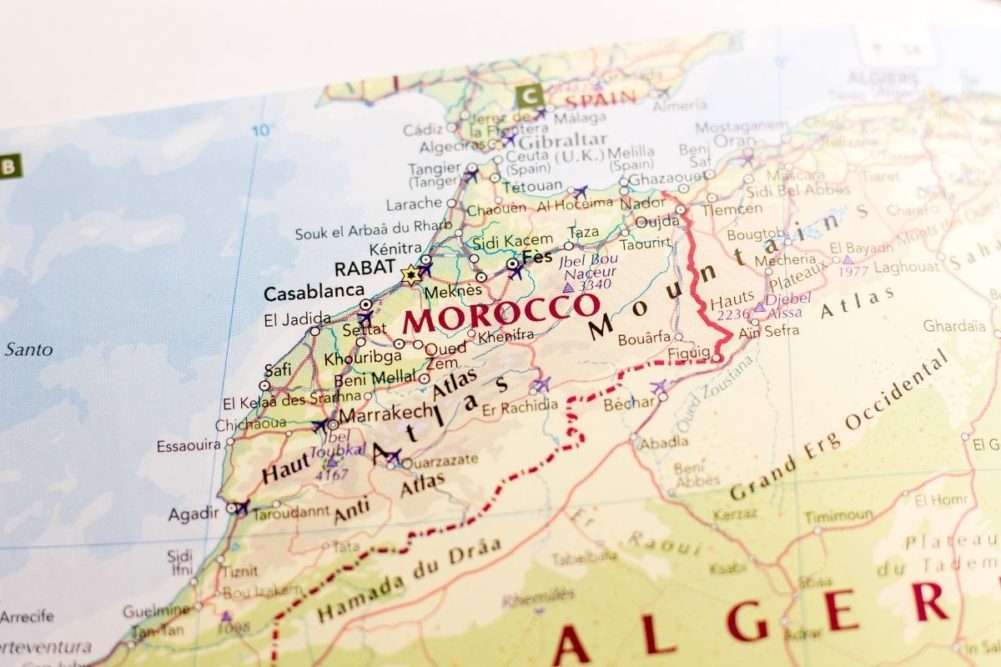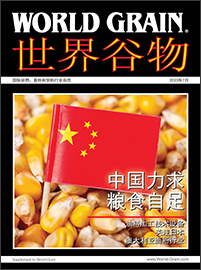KANSAS CITY, MISSOURI, US — Despite a location on the edge of the enormous Sahara Desert, parts of Morocco are rainy and well suited to producing grains. However, the climate is variable and, with a national diet in which wheat plays an important role, the country is a major importer. It is an important customer of French exporters and enjoys a close political relationship with the European Union.
The International Grains Council (IGC) puts Morocco’s total grains production in 2021-22 at 11.1 million tonnes, up from 3.4 million in 2020-21. Wheat production rose to 8.1 million tonnes from the previous year’s 2.6 million, while 2021-22 output of barley was up at 2.8 million tonnes from 2020-21’s 600,000 tonnes.
Morocco’s total grains imports are set to fall to 7.0 million tonnes, from 8.4 million in 2020-21. Wheat imports are put at 4.4 million tonnes in the current season, down from the previous year’s 5.1 million. Corn imports in 2021-22 are predicted to fall to 2.3 million tonnes, down from 2.9 million. Imports of barley will fall slightly, to 400,000 tonnes from 500,000 last year.
In a Sept. 13 update, the USDA attaché provided official estimates.
“On July 26, 2021, the Government of Morocco released its final wheat and barley production numbers for the 2021 crop (5.06 million tonnes of common wheat, 2.48 million tonnes of durum wheat, and 2.78 million tonnes of barley),” they said. “This harvest performance is mainly due to abundant rainfall during the growing season, which was 32% higher than the previous year,” the attaché explained. “The growing regions of Chaouia, Abda, Haouz, Tadla, and Sais recorded yields 44% above the 10-year average.”
Moroccan wheat imports are expected to return to normal levels in marketing year 2021-22, the attaché said, forecasting imports at 4.5 million tonnes primarily from common wheat suppliers in France, Ukraine and Russia.
“Canada is expected to remain Morocco’s primary durum wheat supplier,” the report said. “US wheat remains priced out of the Moroccan market.”
The attaché explained in an annual report on the grains sector that “Moroccan wheat, flour, and bread prices are politically sensitive and thus strictly managed,” with the National Inter-Professional Office for Cereals and Legumes (ONICL) aiming to control the price of wheat within a $260- to $280-per-tonne range by managing the most favored nation tariff rate. ONICL subsidizes common wheat flour, known as “National Flour” in an effort to support low-income consumers.
The attaché put Morocco’s rice production in 2021-22 at 45,200 tonnes, 7% up from the previous year, due to favorable weather during the growing season.
“Rice is not a staple food in Morocco and the consumption has not increased significantly in recent years as consumers continue to opt for bread wheat, couscous, and vegetables,” the report said, putting consumption steady at 105,000 tonnes.
The report quotes Thailand’s exports of rice to Morocco at 31,562 tonnes in 2019-20, making it the major supplier with 44% of the total. The attaché forecast 2021-22 imports at 60,000 tonnes “if the COVID-19 pandemic is managed and the tourism sector resumes.”
The importance of the Moroccan market to France is demonstrated by the fact that the export promotion organization France Export Céréales, taken over by sector body Intercéréales on July 1, 2021, maintains an office in Casablanca.
In its 2019-2020 report on its activities, France Export Céréales put France’s share of the Moroccan soft wheat market at 50%, making it the biggest supplier, but added that there was strong competition from Ukraine and Russia. Discussing the 2019-20 marketing year, it noted strong demand for barley, because of the poor Moroccan crop. However, having gained a share of 80% of Moroccan barley imports in 2018-19, stronger competition cut France’s share to 63%. France also gained ground on durum wheat exports to Morocco that year, but Canadian supplies were still Moroccan importers’ preferred choice.
The 2020 edition of the annual report on the flour milling sector published by Fédération Nationale de la Minoterie (FNM), Morocco’s milling industry association, puts the number of industrial mills processing soft wheat in the country at 125, with a further 20 milling durum and eight producing barley flour.
At the end of 2019, the country had 11 million tonnes of grain processing capacity, 85% of which was used for soft wheat. The amounts processed in 2019 were 4.4 million tonnes of soft wheat, 900,000 tonnes of durum and 830,000 tonnes of barley.
FNM puts the average consumption of wheat per inhabitant of Morocco at 200 kilograms, or three times the global average.
In a Dec. 11, 2020, report on biotechnology, the USDA attaché notes that “Morocco neither produces nor allows importation of agricultural products derived from biotechnology for human consumption,” but adds that it “does import genetically engineered (GE) products for its livestock and poultry sectors.”
The report points to government guidance on the country’s position on biotech products, published in September 2012, which states that “Morocco follows the precautionary principle in respect to justifying the ban on GE products from local cultivation and from their presence in products for human consumption, while simultaneously recognizing their international presence and acceptance as an animal feed source.”
However, Morocco is actively engaged in agricultural biotechnology research and development as a means for addressing the country’s food security challenges.
“This work is led by the National Agronomic Research Institute (INRA) and focused on finding solutions for Morocco’s major crops, including cereals, forage, date palm, citrus, and olives,” the attaché said. It points out that Morocco is a major importer of soy products from the Americas and corn from Argentina, as well as sugar from Brazil.
“Imported feed ingredients are a necessity for Morocco’s livestock and poultry industries, which are currently expanding,” the report said.
For the European Union, Morocco is its biggest trading partner in what it calls its “Southern Neighborhood.” A Free Trade Area – part of the EU-Morocco Association Agreement – was agreed in 1996 and entered into force on March 1, 2000.
An agreement on additional liberalization of trade in agricultural products, processed agricultural products, and fish and fisheries products, entered into force in October 2012. According to the European Commission’s website, “trade in industrial products is entirely liberalized, while market opening for agricultural products is also substantial.”
On Sept. 29, 2021, the EU’s General Court declared the trade deals invalid, because they were reached without consent of the people of Western Sahara. The decision concerned two cases brought by the Front populaire pour la libération de la Saguia el-Hamra et du Rio de oro (Front Polisario), an organization seeking independence for the region. The Court did not, however, order the suspension of the operation of the deals.
The EU and Morocco are both eager to sort this out, both for economic reasons and because of the wider political importance of Europe’s relationship with Morocco. In a joint statement responding to the court’s judgment, Morocco’s Foreign Affairs Minister Nasser Bourita, and Josep Borrell, high representative of the EU for Foreign Affairs & Security Policy, said they had “taken note of the judgments delivered by the General Court of the European Union.”
They said they would “take the necessary measures to ensure the legal framework which guarantees the continuity and stability of trade relations.”
“We remain fully mobilized to maintain cooperation between the European Union and the Kingdom of Morocco, in a climate of serenity and commitment,” they added.





